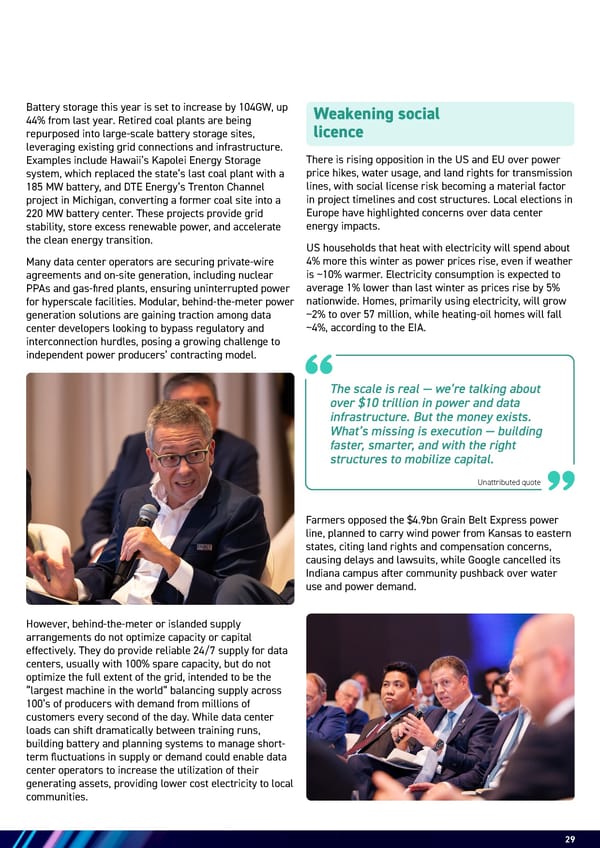29 29 Unattributed quote There is rising opposition in the US and EU over power price hikes, water usage, and land rights for transmission lines, with social license risk becoming a material factor in project timelines and cost structures. Local elections in Europe have highlighted concerns over data center energy impacts. US households that heat with electricity will spend about 4% more this winter as power prices rise, even if weather is ~10% warmer. Electricity consumption is expected to average 1% lower than last winter as prices rise by 5% nationwide. Homes, primarily using electricity, will grow ~2% to over 57 million, while heating-oil homes will fall ~4%, according to the EIA. Weakening social licence Battery storage this year is set to increase by 104GW, up 44% from last year. Retired coal plants are being repurposed into large-scale battery storage sites, leveraging existing grid connections and infrastructure. Examples include Hawaii’s Kapolei Energy Storage system, which replaced the state’s last coal plant with a 185 MW battery, and DTE Energy’s Trenton Channel project in Michigan, converting a former coal site into a 220 MW battery center. These projects provide grid stability, store excess renewable power, and accelerate the clean energy transition. Many data center operators are securing private-wire agreements and on-site generation, including nuclear PPAs and gas-fired plants, ensuring uninterrupted power for hyperscale facilities. Modular, behind-the-meter power generation solutions are gaining traction among data center developers looking to bypass regulatory and interconnection hurdles, posing a growing challenge to independent power producers’ contracting model. Farmers opposed the $4.9bn Grain Belt Express power line, planned to carry wind power from Kansas to eastern states, citing land rights and compensation concerns, causing delays and lawsuits, while Google cancelled its Indiana campus after community pushback over water use and power demand. However, behind-the-meter or islanded supply arrangements do not optimize capacity or capital effectively. They do provide reliable 24/7 supply for data centers, usually with 100% spare capacity, but do not optimize the full extent of the grid, intended to be the “largest machine in the world” balancing supply across 100’s of producers with demand from millions of customers every second of the day. While data center loads can shift dramatically between training runs, building battery and planning systems to manage short- term fluctuations in supply or demand could enable data center operators to increase the utilization of their generating assets, providing lower cost electricity to local communities. The scale is real — we’re talking about over $10 trillion in power and data infrastructure. But the money exists. What’s missing is execution — building faster, smarter, and with the right structures to mobilize capital.
 Energy & AI: Twin Engines Turbo-Charging Economic Growth Page 28 Page 30
Energy & AI: Twin Engines Turbo-Charging Economic Growth Page 28 Page 30